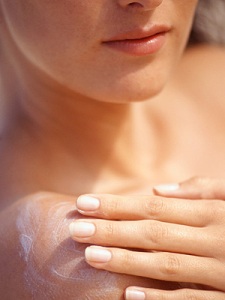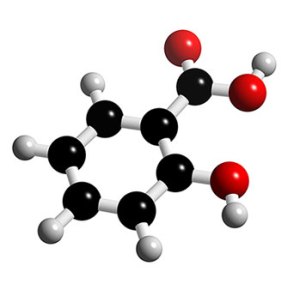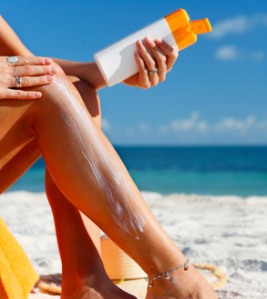
When it comes to skincare advice a few sources of information consistently upset me. One is all the misinformation on the web about skincare (one of the reasons I started this blog was to “combat” all that misinformation) and the other is the so-called skincare advice found in glossy fashion magazines. Now I love fashion magazines – LOVE them – but for the fashion not for the skincare advice. I do love to get make-up advice and tips for fashion magazines, but for me fashion magazines consistently fall short when it comes to skincare advice. Either the advice given is basic, even out-dated or it is just downright wrong or ridiculous. In my opinion only Allure and Elle actually do real in-depth research about skincare issues and trends.
One beauty editor who constantly gets my goat is Jean Godfrey-June, the beauty editor at Lucky magazine. I happen to love Lucky for the fashion advice because they highlight trends and clothes that I can actually afford and would want to wear. I love the way they style the clothes as well. But when it comes to skincare advice Lucky sucks, in my opinion. In particular the advice that Godfrey-June gives in her monthly column “The Beauty Closet” makes me want to scream. Since I took the time to read Godfrey-June’s book about being a beauty editor I now know that she has absolutely no expertise in skincare beyond reporting about it (see my review of her book). I can take or leave her make-up advice, but her skincare advice is so completely off base at times that I felt I needed to mention it here in this blog. For example in the June issue of Lucky in the article “Clear Skin Forever: 12 Rules for achieving a perfect complexion no matter how bad you think it is” rule number 5 is:
The only topical treatment to even slightly faze the dreaded body acne is copious amounts of isopropyl alcohol.
This is completely terrible advice! Isopropyl alcohol is drying and irritating for the skin. On top of that it can create free radical damage in the skin. And I should add that this is not the first time that the beauty staff at Lucky has recommended isopropyl alcohol as a treatment for body acne. (By the way, the correct way to treat body acne is exactly how you would treat the acne on your face. Look for products with AHA, salicylic acid, and benzoyl peroxide in them)
And then in the same issue there was this gem of advice regarding sunscreen:

Anyone who has ever looked for a no-artificial-chemicals, all-mineral, whole-body sunscreen that does not leave you covered in a whitish film has been, until now, a very frustrated person. This brilliant, answer-to-all-my-dreams SPF30 sinks in instantly, miraculously.
And no, it has no nanoparticles either (if you’re the sort of person searching for the above ultimate formula, you do not want nanoparticles). And it smells nice! Like … lotion. That unobtrusive-yet-somehow-comforting lotion smell.
YES TO CARROTS HYDRATING BODY LOTION WITH SPF30, $15, DRUGSTORES
So perhaps you are wondering – what made me so upset about this product recommendation? Let me explain. First of all there are many, many great sunscreen formulations out there that include chemical ingredients and will not damage your skin. Yes, some people do believe that physical blocks ( titanium dioxide and zinc oxide) are the best sunscreen ingredients just as many people believe that chemical sunscreen ingredients are just as effective as the physical ones and in some cases even better because they are longer lasting for one thing. It all comes down to finding a sunscreen that you like and that works well with your skin type (and that you like enough to reapply throughout the day). Chemical, physical ingredients – just use your sunscreen please!
But what was written about nanoparticles really bugged me since Godfrey-June states that if you want an all mineral sunscreen you also do not want nanoparticles in your sunscreens. Of course, she doesn’t explain what nanoparticles are or why you would want to avoid products with them.
I had actually been meaning to address the issue of nanoparticles in sunscreens for some time and seeing this item in Lucky finally prompted me to write this post. The issue of nanoparticles in sunscreens is far from a simple issue and when it comes to nanoparticles in sunscreens in particular different, very credible, sources actually have come out in defense of their use in sunscreens.
What Are Nanoparticles?
Simply put nanoparticles are tiny particles (a nanometer is one billionth of a meter) of an ingredient. Scientists shrink ingredient particles to such small microscopic size in order for the ingredient to be able to penetrate cell membranes. When it comes to sunscreen the ingredients that are nanosized are zinc oxide and titanium dioxide so that sunscreens do not leave a white film when applied to the skin. The use of nanotechnology in sunscreens improves the aesthetic quality of the sunscreen and thus makes it much more likely that consumers will be willing to use the sunscreen.
The use of nanoparticles is certainly not limited to skincare products. Nanoparticles can be found in a range of products from toothpaste to nutritional supplements to food colorants.
The Controversy Over Nanoparticles
The controversy with nanoparticles stems from research that suggests that when nanoparticles are absorbed into the skin, inhaled, or other wise consumed they can damage chromosomes and cause inflammation that could lead to cancer. But the data about nanoparticles/nanotechnology is far from conclusive and far from exhaustive. Much more research needs to be done about this new field of technology before a general conclusion can be reached that nanotechnology is dangerous to humans.
When it comes to skincare products and nanotechnology it must be remembered that even if there is data that nanotechnology can be harmful to humans it might not be harmful in all forms. Inhaling and consuming products with nanoparticles might be much more dangerous than spreading a product on your face with nanoparticles. This is the very point about nanotechnology that has to do with sunscreens.
Sunscreens and Nanotechnology
Most sunscreens sit on top of the skin and do not penetrate past the the very top layer of the skin. As such the use of nanoparticles in sunscreens do not pose a threat to consumers. But don’t just take my word for it. The Environmental Working Group, a non-profit organization of scientists, engineers, lawyers, and policy makers that researches and advocates on issues of public health and the environment, reached the same conclusion in their annual report on sunscreens in 2009. The EWG is a watch dog group that does extensive research on a huge range of subjects that affect public health and their conclusions can be taken seriously.
Instead of paraphrasing the EWG report I will instead highlight some of the important points from the report here. I want to quote quite a bit of the report since it does a great job of explaining the risks involved with the nanoparticles in sunscreens and then fully explains the conclusions of different research studies about nanoparticles and sunscreens.
I get the feeling that people are having a knee jerk reaction to nanoparticles in sunscreens like they do to the issue of parabens in skincare products. There is a lot of smoke and mirrors and hysteria without any real scientific evidence to support the fears that people express over those ingredients. So please read the excerpts below. You’ll find a link to the full report at the end of this post.
Nanotechnology and Sunscreens by the Environmental Working Group:
When we began our sunscreen investigation at the Environmental Working Group, our researchers thought we would ultimately recommend against micronized and nano-sized zinc oxide and titanium dioxide sunscreens. After all, no one has taken a more expansive and critical look than EWG at the use of nanoparticles in cosmetics and sunscreens, including the lack of definitive safety data and consumer information on these common new ingredients, and few substances more dramatically highlight gaps in our system of public health protections than the raw materials used in the burgeoning field of nanotechnology. But many months and nearly 400 peer-reviewed studies later, we find ourselves drawing a different conclusion, and recommending some sunscreens that may contain nano-sized ingredients.
Consumer Reports (2007) testing showed that consumers can be protected from UV radiation using products free of nano-scale ingredients like zinc and titanium. We expected to find this as well, but we took our study further than Consumer Reports to be certain. We looked not only at whether or not products provide broad-spectrum UV protection, but also at which sunscreens break down in the sun, and at the full range of potentially hazardous sunscreen ingredients that can absorb through the skin and into the body to pose other risks. Our answers changed.
Our study shows that consumers who use sunscreens without zinc and titanium are likely exposed to more UV radiation and greater numbers of hazardous ingredients than consumers relying on zinc and titanium products for sun protection. We found that consumers using sunscreens without zinc and titanium would be exposed to an average of 20% more UVA radiation — with increased risks for UVA-induced skin damage, premature aging, wrinkling, and UV-induced immune system damage — than consumers using zinc- and titanium-based products. Sunscreens without zinc or titanium contain an average of 4 times as many high hazard ingredients known or strongly suspected to cause cancer or birth defects, to disrupt human reproduction or damage the growing brain of a child. They also contain more toxins on average in every major category of health harm considered: cancer (10% more), birth defects and reproductive harm (40% more), neurotoxins (20% more), endocrine system disruptors (70% more), and chemicals that can damage the immune system (70% more) (EWG 2007).
We also reviewed 16 peer-reviewed studies on skin absorption, nearly all showing no absorption of small-scale zinc and titanium sunscreen ingredients through healthy skin. In a 2007 assessment the European Union found no evidence of nano-scale particles absorbing through pig skin, healthy human skin, or the skin of patients suffering from skin disorders (NanoDerm 2007). Overall, we found few available studies on the absorption of nano-scale ingredients through damaged skin, but nearly all other sunscreen chemicals approved for use in the U.S. also lack these studies.
On balance, EWG researchers found that zinc and titanium-based formulations are among the safest, most effective sunscreens on the market based on available evidence. The easy way out of the nano debate would be to steer people clear of zinc and titanium sunscreens with a call for more data. In the process such a position would implicitly recommend sunscreen ingredients that don’t work, that break down soon after they are applied, that offer only marginal UVA protection, or that absorb through the skin.
If this were nano-containing eye shadow, blush, or body glitter our position would be different — if it’s not protecting your health, don’t use it. But sunscreen is meant to protect us from exposure to a known human carcinogen, UV radiation, responsible for some of the more than one million cases of skin cancer diagnosed in this country every year.
EWG conducted our sunscreen study because comprehensive sunscreen safety standards have not yet been set in this country. FDA has been drafting these standards for 31 years, and still has set no firm deadline for finalizing their latest proposed rule, issued in August 2007. FDA has also not yet evaluated sunscreen chemicals that are widely available in other parts of the world and that could potentially replace nanoparticles in sunscreen.
EWG has called for more safety studies for all sunscreens, nano or not. We’ve called for more data to understand when and in what amounts these ingredients penetrate the skin, and we’ve advocated for science-based assessments of health risks, so that everyone from consumers to health officials at FDA will know that we have the best possible products on the market. For nano-scale ingredients we have also called for full labeling so consumers can make informed choices.
safety concerns surrounding nanomaterials lead some manufacturers’ choice to label their products as free of nanoscale zinc and titanium. EWG’s 2009 analysis of sunscreens identified 16 manufacturers claiming to steer free of nanoparticles.Consumers should view such claims with skepticism. FDA has neither set standards for nanoparticle claims nor defined the maximum dimensions of a nanoparticle. Products claiming to be nano-free do not divulge the size of the particles used instead. Friends of the Earth has called for consumers to avoid zinc and titanium-based sunscreens unless manufacturers specify that they use no nanoparticles (FOE 2007). A more reliable criteria is the color of the sunscreen: larger particles leave a white coating on the skin.
Sunscreen manufacturers have used nano-scale titanium dioxide since 1990 and nano-scale zinc since 1999. Now the typical size for titanium in sunscreens is 10-100 nm for titanium and 30 to 200 nm for zinc (Nohynek 2007). At these sizes both zinc and titanium are nearly transparent. An estimated 1,000 tons of nanoparticles were used in sunscreen worldwide from 2003 to 2004 (Börm 2006). Nano zinc and titanium are thought to be widely used in US sunscreens, although they are rarely labeled as such. The common label terms “micronized” and “ultra-fine” do not preclude the presence of nano zinc or titanium in sunscreen. Consumer Reports recently tested 8 mineral sunscreens and detected nanoparticles in each one (Consumer Union 2007).
The European Union and Australian cosmetic regulatory bodies have reviewed the toxicity of zinc and titanium nano-ingredients in sunscreen. In 2000, the EU approved nanoscale titanium for use in sunscreen, concluding that the chemical does not penetrate the skin or present risks for cytotoxicity, phototoxicity, or genotoxicity (SCCNFP 2000). In 2004 the same panel reviewed nano-scale zinc and found the evidence insufficient to support its use in sunscreen. The panel could not preclude the possibility that nanoscale zinc might penetrate the skin or damage human DNA (SCCNFP 2004). In 2005 the panel called for additional study by manufacturers to evaluate these concerns (SCCP 2005). The EU Scientific Committee on Consumer Products recently recommended a case-by-case risk assessment of all nanoparticles used in cosmetics, particularly those particles that are insoluble and biopersistent, with the potential to build up in body tissues (SCCP 2007).
In 2006 the Australian Therapeutic Goods Administration concluded that the weight of evidence showed no penetration of nanoscale zinc and titanium to viable skin cells (Australia TGA 2006). The US has not evaluated the safety of nanoscale zinc and titanium in sunscreen. The FDA considers their approval of zinc and titanium as sunscreens to encompass all particle sizes.
Zinc oxide and titanium dioxide offer moderate to strong UVA protection. In the nano size range UVB protection increases and UVA protection decreases. These 2 chemicals are among only 4 US-approved sunscreens providing significant UVA protection. The remaining two, Avobenzone and Mexoryl SX, provide UVA-I protection. However Avobenzone can be quite unstable and Mexoryl is not widely sold in the U.S. Two alternative UVA blockers, Tinosorb S and Tinosorb M, have been used in Europe since 2000 but have not yet been approved by FDA.
The European Union-funded NanoDerm project conducted a series of experiments over 3 years and found no evidence of dermal penetration in human and pig skin using a variety of analytical techniques, titanium types, and test conditions. NanoDerm focused on titanium penetration since zinc is not approved for use in European sunscreens. They observed that nano-scale titanium particles often aggregated into larger masses on skin, and penetrated deepest in hair shafts. The project also performed absorption studies on skin samples from several patients with psoriasis, which has been a particular concern because skin affected by this condition lacks a protective barrier. Titanium particles penetrated nearly to the level of living skin cells (keratinocytes), but researchers found no evidence that the particles reached the bloodstream. None of their 11 publications found evidence that nano-scale titanium reached “vital tissues” (NanoDerm 2007; Kiss 2008).
EWG separately reviewed results from 16 academic experiments representing a variety of skin types (mouse, pig or human skin) and including nano-scale titanium and zinc. All of the studies examining human skin or pig skin (the most suitable surrogate for human skin) conclude that very few particles, if any, reach living skin cells (Cross 2007; Dussert 1997; Gamer 2006; Gottbrath 2003; Kiss 2007; Lademann 1999; Landsdown 1997; Mavon 2007; Menzel 2004; NanoDerm 2008; Pflücker 2001; Pirot 1996; Schulz 2002; Tan 1996; Wu 2000; Zvyagin 2008). The only signs of penetration come from studies of hairless mice, whose skin is much more permeable than human or pig skin (Kuo 2009; Wu 2009).
One recent study found no titanium particle penetration and limited zinc particle penetration (1.5 to 2.3%), though the study is difficult to interpret because of apparent background contamination of laboratory materials by zinc (Gamer 2006). Hair follicles make up 0.1% of the skin surface and can be potential openings for deeper movement of nanoparticles into skin. Penetration studies for nano zinc and titanium note accumulation of the particles in follicles, but no movement into deeper tissues (Lademann 1999, 2005, 2006, 2007; NanoDerm 2007).
The available research, including studies of psoriatic skin tested by NanoDerm, does not completely address the potential for penetration in damaged skin. Sunburned skin might be more permeable, as might skin of children or the elderly, or thinner skin that occurs in some areas of the body. The NanoDerm assessment concluded that sunscreen containing titanium nanoparticles should not be applied to open wounds, and called for more study of psoriatic skin, which has a damaged outer protective barrier.
Two studies find direct evidence of skin penetration to hairless mice (Kuo 2008, Wu 2009). Hairless mouse skin is less than half as thick as human skin and is a poorer barrier to absorption (Kuo 2009). The European Union’s Scientific Committee on Cosmetic Products considers it to be a poor proxy for human exposure (SCCP 2006).
Conclusions
Our assessment of the comparative benefits of zinc and titanium sunscreens that might contain nanoparticles is obviously not meant as an endorsement of all nano-scale products nor the manufacturing processes. But we find nano-scale zine and titanium to be reasonable choices for use in sunscreen, particularly given the known hazards of UV exposure, and the limited choices for UV protection in the United States. We are concerned about the potential for nanoparticle inhalation with powder or spray forms of mineral sunscreens, particularly given marketing claims promoting their use on faces and on children’s skin. EWG urges consumers to avoid mineral-based sunscreens sold in powder or spray forms, and for manufacturers of these products to avoid using nano-scale particles. Consumers can expect a wider range of safe and effective products when FDA finalizes comprehensive sunscreen standards and reassesses the safety of all sunscreens to ensure they are effective and that they are safe for people and the environment alike.
Bottom Line
I trust the research done by the EWG and see absolutely no reason to be concerned about nanoparticles in sunscreens that are rubbed into the skin. Remember to always take the skincare information that you read in glossy fashion magazines with a grain of salt. The people writing those articles are journalists not dermatologists, not estheticians, and not scientists. Do your own research before reaching conclusions.
And one last word about sunscreens. I think the Skin Cancer Foundation says it best:
Consumers should rest assured that sunscreen products are safe and effective when used as directed. Since our inception 30 years ago, The Skin Cancer Foundation has always recommended using a sunscreen with an SPF 15 or higher as one important part of a complete sun protection regimen which includes seeking the shade and covering up with clothing.
So get out your sunscreen, with or without nanoparticles, and use it!
Sources:










 Anyone who has ever looked for a no-artificial-chemicals, all-mineral, whole-body sunscreen that does not leave you covered in a whitish film has been, until now, a very frustrated person. This brilliant, answer-to-all-my-dreams SPF30 sinks in instantly, miraculously.
Anyone who has ever looked for a no-artificial-chemicals, all-mineral, whole-body sunscreen that does not leave you covered in a whitish film has been, until now, a very frustrated person. This brilliant, answer-to-all-my-dreams SPF30 sinks in instantly, miraculously.



Recent Comments